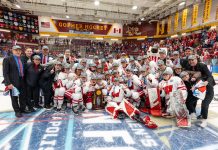
The past two years offered some of the most shape-shifting and chaotic times in college hockey.
Conferences realigned, teams expanded and contracted, and new leagues formed.
Future changes were thrust into a white-hot spotlight, and the bedrock emotional culture of the sport ranged from anxiety and fear to excitement and anticipation.
Through it all, ECAC Hockey long stood as a pillar of stability. Even after three-quarters of the league’s membership opted out of the 2020-21 season, the conference remained intact, and the 2021-22 season returned the dialectical sides of its membership to the commonly-paved road stretching from October to March.
The only problem was how the league looked upon its return. Losing that one year forced proud programs to enter full-blown rebuilds on their rosters, and ECAC spent most of last year clearly behind its peers in the race to the national tournament. It took Harvard’s postseason tournament championship to avoid becoming a one-bid league, and despite Quinnipiac winning the second-most regular-season games in the nation, the Bobcats entered the tournament as a No. 2 seed behind more powerful teams from the NCHC and CCHA.
To a degree, it didn’t matter because the rest of the league was back, but as the 2022-23 season dawns, the fight to fully move past COVID centers on efforts to restore ECAC’s prominence as games get underway for the six teams not affiliated with the Ivy League’s usual delayed start.
“Getting good is the easy thing, but staying there is harder,” said Clarkson coach Casey Jones. “I think what I’m most proud of is that we have a culture where our guys really like to work towards their development, so when we recruit a guy, it’s the right type of player that we’re getting. Guys are serious about [getting better]. They want an education, and they’re serious hockey players. We enjoy it at the rink as a staff, and we’re proud that we’ve been able to forge our name with historical value to our program.”
The Golden Knights are expected to rank right next to Quinnipiac as the conference’s cream programs this year, but getting the league back to multiple bids will require more wins from a conference that’s been historically strong from top to bottom.
Harvard, for example, won the Whitelaw Cup last year, but the Crimson play six games against its own conference, including its first four games against fellow Ivy League teams, before it plays a non-league game against New Hampshire. Two games at Michigan await after that, and a late-December matchup against Boston University offers juicy possibilities before the Beanpot in February.
Winning any number of those games could boost the Crimson past last year’s 18th-place finish in the Pairwise and negate the need to win the postseason tournament, but success outside of the conference is likely to pull other teams with it. A team like Cornell finished 24th in the Pairwise last year, and a better coefficient against other conferences is easily constructible if the Big Red defeat grab wins at Minnesota Duluth or Boston University while avoiding slips against Sacred Heart or UConn.
“There’s a lot of refocus going on in our program and kind of getting back to the basics,” said Cornell coach Mike Schafer. “We learned some lessons as a coaching staff last season and learned some lessons as a team, and I’m excited for our season to begin and see where this journey will take us. Expectations have always been high around our program, so we’re looking forward to proving ourselves.”
The upper echelon of the league likely won’t change – the preseason coaches poll reflected that opinion by putting Quinnipiac, Harvard, Clarkson and Cornell in the top four slots – but the real underpinning of the league’s return to prominence will rely on the undercurrent of development that occurred at the remaining schools, where a perceived chasm separated the conference’s preseason poll into clear tiers.
A decided drop separated fourth-place Cornell from fifth-place Colgate, but RPI’s seven vote differential from the Raiders reflected last year’s finish. Another drop moved from the duo down to Union and Dartmouth in the transition spot for home ice in the postseason, while two more separators explained the perceptions between Yale and the bottom two pairing of Brown and Princeton, and how the teams advance or disprove prognosticators is more related to how teams with the aforementioned rebuilds are able to progress into a second year.
“We had 16 kids who suited up last year that had never played college hockey,” Dartmouth coach Reid Cashman said, “and the unique challenge at Dartmouth was that I was the only new head coach. My first day of practice, we had 29 guys that didn’t know if a drill was the same drill they ran the year before. Our freshmen couldn’t look at our seniors and ask what the expectations were, and they all kind of learned it at the same time. That was exciting for us as a staff, but there was a big challenge and a big learning curve.”
“We’re just trying to work every day so that when the puck is dropped, we’re performing the way that I think we can,” added Brown coach Brendan Whittet. “Where that puts us at the end of the year, time will tell, but I’ve been here for 14 years and like the makeup of the team. I like the way we’re trending and the mix of guys that we have, and I think this year could be a special year. What we make of it will be up to us, each and every time we step out on the ice.”

BROWN
HEAD COACH: Brendan Whittet, entering his 14th season at Brown
LAST SEASON: 7-20-4 overall (6-12-4, 25 points, ninth in ECAC)
KEY RETURNING PLAYERS: D Luke Krys (Sr., 3g-10a-13pts); D Samuli Niinisaari (Sr., 1g-11a-12pts); F Nathan Plessis (Sr., 3g-4a-7pts); D James Crossman (1g-2a-3pts); G Mathieu Caron (6-14-4; 2.74 GAA; .911 SV%)
KEY LOSSES: F Justin Jallen (10g-7a-17pts); F Tristan Crozier (6g-9a-15pts); F Michael Maloney (10g-3a-13pts)
KEY ADDITIONS: F Ryan Bottrill (Maryland Black Bears, NAHL); D Nick Traggio (Bonnyville Pontiacs, AJHL)
2022-23 PREDICTION: Losing seven straight over the first two months made Brown look cooked, but after dropping a 4-0 defeat to Providence around Thanksgiving, the Bears found their sea legs and pushed their way into the home ice conversation by winning hockey games. A home sweep over Harvard and Dartmouth included back-to-back shutout wins for the first time since the 2009 postseason, and a win over Cornell plus earning extra points in shootout wins over Union and St. Lawrence kept them in the fight until the last day of the season.
Falling short was a reflection on how last year started, and the Bears should avoid some of the issues associated with October and November by having a full offseason to train. Goaltender Mathieu Caron could very well wind up on an All-ECAC team this year, and defensemen Luke Krys and Samuli Niinisaari are two-way threats capable of playing Zdeno Chara-like minutes. Getting James Crossman back healthy should also help the blue line continue to build depth.
The more significant issue is up front, where Brown lost virtually all of its goal scoring from last year’s line chart. That likely means some growing pains and a possibility of a second consecutive slow start, which itself would be problematic given the eight league games to start the year. If someone emerges and the Bears survive that stretch, then things could get real interesting once the team clears its non-conference hurdles.
PREDICTED FINISH: Ninth
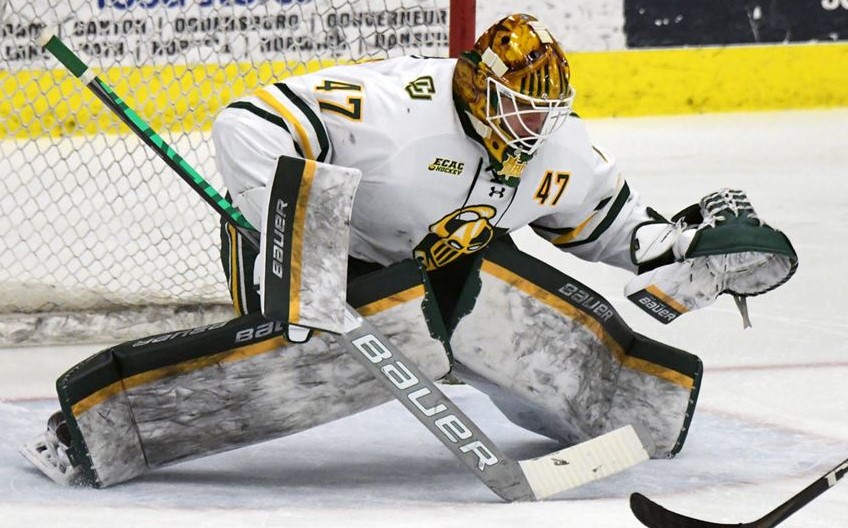
CLARKSON
HEAD COACH: Casey Jones, entering his 12th season at Clarkson
LAST SEASON: 21-10-6 overall (14-4-4, 51 points, second in ECAC)
KEY RETURNING PLAYERS: F Alex Campbell (16g-17a-33pts); F Mathieu Gosselin (11g-22a-33pts); F Ayrton Martino (7g-22a-29pts); F Anthony Romano (15g-13a-28pts); D Noah Beck (5g-17a-22pts); D Tommy Pasanen (3g-4a-7pts); G Ethan Haider (13-10-5, 2.39 GAA, .908 SV%); G Jacob Mucitelli (8-0-1, 1.30 GAA, .944 SV%)
KEY LOSSES: D Lukas Kaelble (7g-15a-22pts); F Luke Santerno (12g-5a-17pts)
KEY ADDITIONS: D Trey Taylor (Youngstown Phantoms, USHL); F Brady Egan (Pembroke Lumber Kings, CCHL); F Brandon Buhr (Alberni Valley Bulldogs; BCHL)
2022-23 PREDICTION: It’s insane to consider how much COVID-19 impacted the last three years, but because of the pandemic, Clarkson’s senior class has never played in a single NCAA tournament game despite winning 60 games and finishing second in ECAC over the last three seasons.
Maybe that doesn’t mean much to this year, but adding more motivation to the Golden Knights is a spicy combination for a team that’s just as good as Quinnipiac. It’s impossible to find holes in the lineup as it is, and removing the usual bumps associated with any season, it’s more believable that Clarkson could lead the league wire-to-wire behind a roster capable of doing everything with multiple goalies who could start anywhere in the country.
There’s a possible postseason preview in Milwaukee when Clarkson plays UMass, and four of the final eight games are against teams projected to enter the postseason with a first-round road series. Considering how it breaks down, there’s a whole lot of momentum available for a team that could very well lead the league wire-to-wire and put pressure on the national conversation.
PREDICTED FINISH: First

COLGATE
HEAD COACH: Don Vaughn, entering his 29th season at Colgate
LAST SEASON: 18-18-4 overall (9-9-4, 33 points, fifth in ECAC)
KEY RETURNING PLAYERS: F Colton Young (15g-17a-32pts); F Alex Young (10g-21a-31pts); F Matt Verboon (10g-18a-28pts); D Nick Anderson (1g-18a-19pts); G Carter Gylander (7-8-0, 2.76 GAA, .908 SV%)
KEY LOSSES: F Josh McKechney (14g-13a-27pts); F Griffin Lunn (12g-7a-19pts); D Elliott McDermott (2g-11a-13pts); G Mitch Benson (10-7-3, 2.39 GAA, .922 SV%)
KEY ADDITIONS: D Reid Irwin (Tr., Denver, NCHC); D Bobby Metz (Minnesota Wilderness, NAHL); F Simon Labelle (Prince George Spruce Kings, BCHL)
2022-23 PREDICTION: Colgate might have finished last year as the No. 5 seed, but the Raiders set the bar for the rest of the league. They started hot, cooled off in the middle of the season, and finished with 18 wins and their first trip to the semifinal round of the postseason since 2015. They won one-goal games, and while some teams finished with better records, few teams did more to maximize a dark horse status.
That’s why it’s okay to expect Colgate to challenge for a top four seed while simultaneously predicting a fifth-place finish. Nearly everyone returns, but it’s up to the blue collar areas – the depth scoring and special teams, along with good goaltending and solid plus/minus numbers – to see about getting the Raiders into that next echelon occupied by the teams perceived as being better at the start of the season.
One thing about the Raiders: they aren’t afraid to travel. They’ll open the season at home but will spend back-to-back weekends in October going to Arizona State and Merrimack at opposite ends of the Division I geographical spectrum, and their non-conference schedule is evenly split and spread out between home and away. A Thanksgiving weekend trip to Niagara is a nice break from home weekends in league play, and the home games against Maine are a good way to shake off any holiday rust before rejoining ECAC play after January 1. Even the end-of-season home-and-home with Cornell and St. Lawrence/Clarkson weekends don’t look bad, and lining up three games at home before ending the year at Yale and Brown could make for a push at whichever team is in the No. 4 spot.
PREDICTED FINISH: Fifth
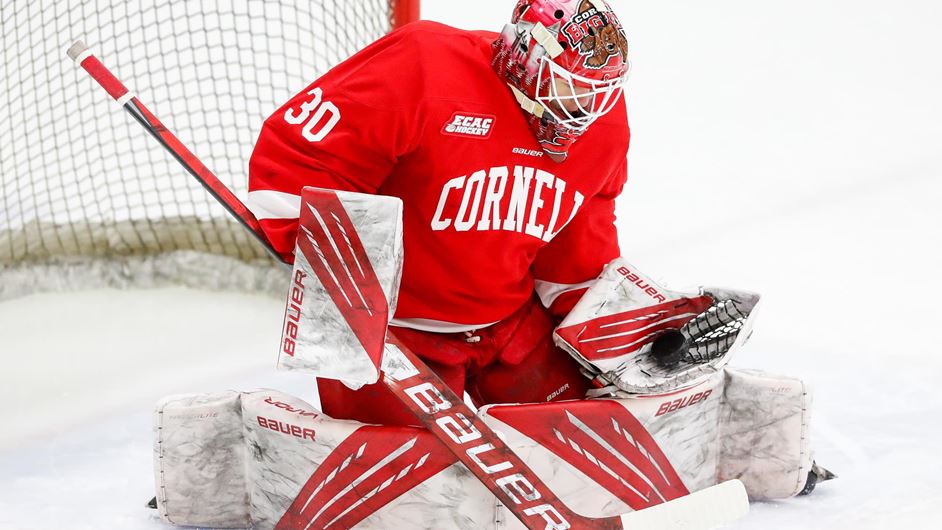
CORNELL
HEAD COACH: Mike Schafer, entering his 28th season at Cornell
LAST SEASON: 18-10-4 overall (12-6-4, 39 points, fourth in ECAC)
KEY RETURNING PLAYERS: F Matt Stienburg (12g-16a-28pts); F Max Andreev (9g-14a-23pts); F Ben Berard (14g-8a-22pts); D Sam Malinksi (4g-17a-21pts); F Ondrej Psenicka (12g-8a-20pts); D Travis Mitchell (3g-12a-15pts); G Ian Shane (7-6-3, 1.72 GAA, .933 SV%)
KEY LOSSES: F Brenden Locke (6g-12a-18pts); F Kyle Betts (6g-11a-17pts); G Nate McDonald (7-1-1, 2.38 GAA, .904 SV%)
KEY ADDITIONS: F Gabriel Seger (Tr., Union, ECAC); G Ryan McInchak (Tr., AIC, Atlantic Hockey)
2022-23 PREDICTION: An absurd amount of scoring, a stodgy lineup, and stingy goaltending made for a striking return to the ice in Ithaca, where Cornell plowed its way to 10 wins in the first half of the year. It was hard to find a hole on the Big Red until a midseason slip in February dropped them out of top-10 consideration, but after clinching a first-round bye with a win over Princeton in the season’s final game, Cornell lost to Colgate in three games and didn’t advance to the semifinals for the first time since 2016.
It doesn’t look like the absence is going to be long-lived, and the lack of rink rust entering last year showed that a program that advanced to three straight NCAA Tournaments before COVID will rightly be in the conversation once the Pairwise numbers shake out. Nearly everyone is back, and it’s likely the losses are overlooked because of what’s returning. If there’s any slip from Quinnipiac and Clarkson, there’s no reason to think the Big Red won’t ascend to the top, a spot they held for the three years leading into the pandemic.
Getting there should be half of the fun after the season opens with two games against Minnesota-Duluth, the Princeton-Quinnipiac weekend and St. Lawrence-Clarkson. Every single one of those games is on the road and precedes the game at Madison Square Garden against Connecticut, two games against four-time Atlantic Hockey champion AIC, and a game at Boston University. If Cornell sweeps or does well in that whole slate, the Big Red could enter the postseason in the same position as Quinnipiac last year.
PREDICTED FINISH: Second

DARTMOUTH
HEAD COACH: Reid Cashman, entering his second season at Dartmouth
LAST SEASON: 7-22-3 overall (5-15-2, 21 points, T-11th in ECAC)
KEY RETURNING PLAYERS: F Sean Chisholm (9g-14a-23pts); D Tanner Palocsik (4g-16a-20pts); F Mark Gallant (11g-7a-18pts); F Braiden Dorfman (8g-10a-18pts); D Ian Pierce (4g-10a-14pts)
KEY LOSSES: G Clay Stevenson (6-14-2; 2.70 GAA; .922 SV%); G Justin Ferguson (1-8-1, 3.98 GAA, .872 SV%)
KEY ADDITIONS: F John Fusco (Tr., Harvard, ECAC); G Cooper Black (Nanaimo Clippers, BCHL); G Mikey Roberts (Taft School, USHS-Prep)
2022-23 PREDICTION: Dartmouth might be the feel-good story in college hockey after returning to the ice last year. Sure, the Big Green finished tied with Yale for 11th, but they pushed RPI to three games in the first round when the majority of people expected the season to go bust after new head coach Reid Cashman essentially rebuilt his team without being able to skate for a year.
How the team builds on that performance is up to a roster that didn’t really lose anything in the offseason. The entire goaltending backline is gone, but it’s otherwise difficult to poke holes through a roster with its returning depth and a recruiting class that carries some good potential. That’s not a guarantee that Dartmouth will make an automatic leap, but it does mean the Big Green did something different from the other teams in the bottom four. Everyone else lost something. Dartmouth didn’t.
Leveling those expectations means the Big Green should be a fun team to follow, and they’ll represent ECAC with Quinnipiac among a Friendship Four field featuring UMass Lowell and UMass in Belfast. The annual Ledyard Classic features Providence, and there’s a seven-game homestand between January and late February.
PREDICTED FINISH: Eighth

HARVARD
HEAD COACH: Ted Donato, entering his 18th season at Harvard
LAST SEASON: 21-11-3 overall (14-6-2, 46 points, third in ECAC)
KEY RETURNING PLAYERS: F Matthew Coronato (18g-18a-36pts); D Henry Thrun (7g-25a-32pts); Alex Laferriere (14g-17a-31pts); F Sean Farrell (10g-18a-28pts); D Ryan Siedem (3g-17a-20pts); G Mitchell Gibson (18-10-1, 2.17 GAA, .918 SV%)
KEY LOSSES: F Casey Dornbach (8g-17a-25pts); F Nick Abruzzese (9g-24a-33pts);
KEY ADDITIONS: D Mason Langenbrunner (Fargo Force, USHL); F Joe Miller (Chicago Steel, USHL); F Casey Severo (Madison Capitols, USHL); Philip Tresca (Muskegon Lumberjacks, USHL)
2022-23 PREDICTION: Simply watching Harvard win its first league championship since 2017 offered a template for other programs to emulate since the Crimson simply didn’t lose. They were never the most dominant team in the ECAC toolbox, but they beat the two best teams in the conference to clinch the championship, and in the NCAA Tournament, they pushed top-ranked Minnesota State to within a goal in the final four minutes of the third period.It felt nondescript, but that’s exactly why Harvard’s likelihood to repeat as champion is just as strong as the likelihood of a new banner winner.
No team has won consecutive titles since Union’s three-peat from 2012-2014, and Harvard has never repeated as conference champion, but the number of returning players combined with a similar road to the top four means the Crimson have a really good chance to add regular season champion to their postseason resume. They’re going to win a ton of games, and their home ice advantage is as dominant anywhere in the country. Even a Beanpot championship, which hasn’t happened since 1993, is very much in the equation.
PREDICTED FINISH: Third
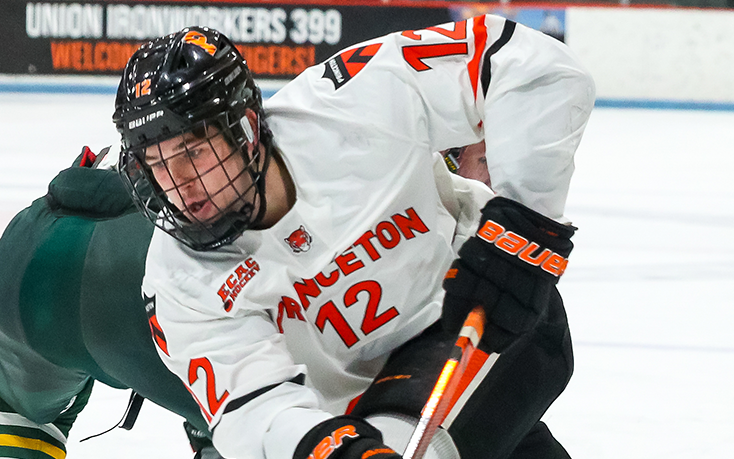
PRINCETON
HEAD COACH: Ron Fogarty, entering his ninth season at Princeton
LAST SEASON: 8-21-2 overall (7-14-1, 23 points, 10th in ECAC)
KEY RETURNING PLAYERS: F Ian Murphy (7g-8a-15pts); F Spencer Kersten (6g-9a-15pts); F Adam Robbins (5g-5a-10pts)
KEY LOSSES: F Corey Andonovski (9g-12a-21pts); F Christian O’Neill (2g-10a-12pts); F Finn Evans (6g-4a-10pts); G Jeremie Forget (6-8-2, 3.49 GAA, .888 SV%)
KEY ADDITIONS: F Kevin Anderson (Notre Dame Hounds, SJHL); F Brandan Gorman (St. Sebastian’s, USHS-Prep); F David Jacobs (Cowichan Valley Capitals, BCHL); D Tyler Rubin (West Kelowna Warriors, BCHL)
2022-23 PREDICTION: Entering last year with an overhauled roster was commonplace in ECAC, but Princeton took some of the more direct shots for a rebuilding team when it lost nine straight games in the first half of the year and ended the year with a second tough stretch. There were a couple of good outings and a high-scoring win over Cornell, but the numbers skewed against the Tigers due to bad nights against Clarkson, Providence, Quinnipiac and Union.
All of the returning pieces should take a step forward, but it’s hard to imagine a Cinderella run with the way the season opens. What opens with a single game against Harvard turns into the Cornell-Colgate weekend and a home-and-home against travel partner Quinnipiac. There’s a weekend against fellow rebuilders Yale and Brown in there, but it’s on the road, and a later, sneaky-tough trip to RIT exists before home games against Clarkson and St. Lawrence.
Princeton is a tough team that will unquestionably embrace that challenge, but it makes the situation hard to predict a path for the Tigers out of the first round. That said, if they can find the right offensive combinations and the defense and goaltending rapidly improves, there’s a very good chance it’s Princeton that kickstarts the next step of its rebuild by jumping into the conversation for home ice.
PREDICTED FINISH: 12th
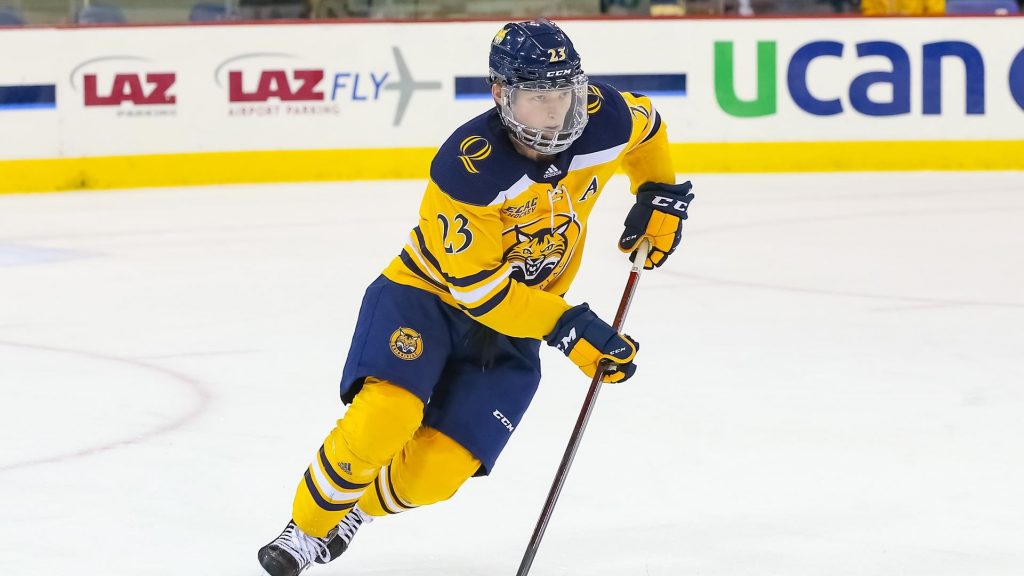
QUINNIPIAC
HEAD COACH: Rand Pecknold, entering his 29th season at Quinnipiac
LAST SEASON: 32-7-3 overall (17-4-1, 54 points, first in ECAC)
KEY RETURNING PLAYERS: D Zach Metsa (10g-27a-37 pts); F Ethan de Jong (11g-21a-32pts); F Michael Lombardi (14g-13a-27pts); F TJ Friedmann (13g-10a-23pts); G Yaniv Peretz (22-5-2, 1.17 GAA, .941 SV%)
KEY LOSSES: F Wyatt Bongiovanni (16g-18a-34pts); F Oliver Chau (13g-20a-33pts); F Ty Smilanic (13g-10a-23pts); G Dylan St. Cyr (10-2-1, 1.16 GAA, .936 SV%)
KEY ADDITIONS: F Collin Graf (Tr., Union, ECAC)
2022-23 PREDICTION: Last year offered the typical, successful standard of winning for a Quinnipiac program that finished first for the third time in four years. Another national tournament berth occurred, and head coach Rand Pecknold was tabbed as the head coach of the 2023 United States National Junior Team after his team caused a conversation about how mathematics and statistics can force a 30-win team into a No. 2 seed.
The Bobcats have a system that works, and there’s really no indication that the team will do anything other than finish near or at the top of ECAC. Goalie Yaniv Perets is the next successor to the long line of goaltending greats, and there isn’t any reason to think the returning firepower can overcome the losses of Wyatt Bongiovanni and Oliver Chau.
It would take a meteor the size of Texas to stop Quinnipiac from finishing in the top four, and it’s likely headed for another national tournament berth with a schedule loaded with the likes of Boston College and North Dakota. The given strength of Harvard, Clarkson and Cornell doesn’t mean a championship is a given, but that also doesn’t mean anyone should bet against the Bobcats.
PREDICTED FINISH: Fourth
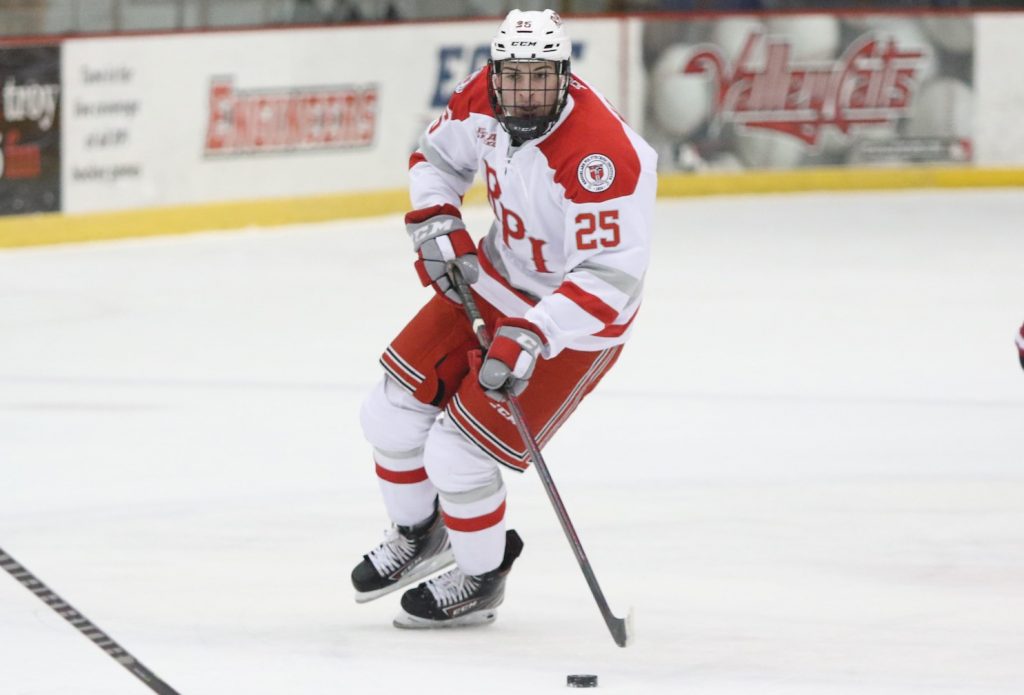
RENSSEALER
HEAD COACH: Dave Smith, entering his sixth season at RPI
LAST SEASON: 18-23-2 overall (10-12-0, 30 points, sixth in ECAC)
KEY RETURNING PLAYERS: F Ryan Mahshie (7g-13a-20pts); F TJ Walsh (4g-15a-19pts); G Jack Watson (9-9-0; 2.39 GAA; .922 SV%)
KEY LOSSES: F Ture Linden (19g-20a-39pts); F Ottoville Leppanen (9g-21a-30pts); D Simon Kjellberg (9g-18a-27pts); F Jakub Lacka (8g-16a-24pts); F Justin Addamo (14g-6a-20pts); F Zach Dubinsky (10g-10a-20pts); D Jake Johnson (2g-14a-16pts); G Linden Marshall (9-13-3; 2.54 GAA; .895 SV%)
KEY ADDITIONS: D Nick Strom (Tr., Western Michigan, NCHC); F Austin Heidemann (Tr., Mercyhurst, Atlantic Hockey); F Brendan Budy (Tr., North Dakota, NCHC); F John Evans (West Kelowna Warriors, BCHL); F Sutter Muzzatti (Austin Bruins, NAHL); G Carson Cherepak (Dauphin Kings, MJHL)
2022-23 PREDICTION: There’s no real way to sugarcoat RPI’s offseason: the Engineers lost their top six scorers either to graduation or the transfer portal, and along with one of their two goalies, there’s more than a few holes that head coach Dave Smith has to plug. Given the interruption caused by opting out of the 2020-2021 season, that also means his fourth-year seniors essentially started their careers, stopped to take a season off, then returned for last year’s third season without any game experience.
That’s the bad news. The good news is that even with the hardships, the team found a way to finish the ECAC season with 10 wins, and after beating Dartmouth in the ECAC First Round, RPI pushed Harvard to two overtime games, including a double-overtime thriller while facing elimination, before essentially paying a one-goal game in the third game. So despite the inherent struggles, there’s a good chance the program can weather the storm and still emerge unscathed, especially if the incoming class produces one or two instant stars.
The better news? The season opens with a favorable schedule that will allow players the opportunity to log valuable ice before the bulk of ECAC play really gets firing. The exhibition against the University of Toronto will help in offering critical minutes, and the first six games are against three Atlantic Hockey teams, an independent and the US National Development team. With plenty of hockey to go around, that’s a great indicator of how a team can gel before conference play starts with the annual home-and-home against Union.
PREDICTED FINISH: Tenth

ST. LAWRENCE
HEAD COACH: Brent Brekke, entering his fourth season at St. Lawrence
LAST SEASON: 11-9-7 overall (7-10-5, 26 points, eighth in ECAC)
KEY RETURNING PLAYERS: F Justin Paul (8g-10a-18pts); F Aleksi Peltonen (4g-10a-14pts); D Philippe Chapleau (4g-9a-13pts); F Max Dorrington (8g-4a-12pts); G Emil Zetterquist (11-16-7, 2.57 GAA, .904 SV%)
KEY LOSSES: F Kaden Pickering (6g-13a-19pts); F David Jankowski (4g-12a-16pts)
KEY ADDITIONS: F Jan Lasak (Janesville Jets, NAHL); F Tomas Mazura (Tr., Providence, Hockey East)
2022-23 PREDICTION: Christmas came early in Canton after goalie Emil Zetterquist opted to return after playing over 2,000 minutes last season for the Saints, and his presence for a fifth season further stabilizes a team featuring returning scoring and defense. If everyone steps forward another year, having a top-flight goalie offers the opportunity for St. Lawrence to surprise people with a possible return run through the ECAC standings.
Both Justin Paul and Max Dorrington developed their scoring touch late in the season and were contributing factors in St. Lawrence’s three-game series win over Brown, and two of Aleksi Peltonen’s four goals came during the postseason series against the Bears and Quinnipiac. Even with the loss of two of the roster’s three top point-tallying skaters, a top-heavy lineup is usually enough to drive an ability to win hockey games.
The schedule is the only thing truly preventing St. Lawrence from earning dark horse status. After playing eight home games before Thanksgiving, the Saints play seven of eight games on the road during a crucial stretch that starts and finishes with grueling road trips to the easternmost part of the league. Combined with the home-and-home against Clarkson and a trip to the Capital District, that’s an exhausting stretch that could make or break anywhere from fourth to eighth place.
PREDICTED FINISH: Sixth

UNION
HEAD COACH: Josh Hauge, entering his first season at Union
LAST SEASON: 14-19-4 overall (9-11-2, 27 points, seventh in ECAC)
KEY RETURNING PLAYERS: F Liam Robertson (13g-6a-19pts); F Chaz Smedsrud (5g-11a-16pts); F Tyler Watkins (4g-12a-16pts); G Connor Murphy (14-18-3, 2.66 GAA, .919 SV%)
KEY LOSSES: F Brandon Estes (7g-22a-29pts); F Collin Graf (11g-11a-22pts); F Gabriel Seger (7g-14a-21pts); D Dylan Anhorn (7g-13a-20pts)
KEY ADDITIONS: F Ethan Benz (St. Cloud Norseman, NAHL); D Greg Japchen (North Iowa Bulls, NAHL); F Colby MacArthur (Summerside Western Capitals, MHL); F Chris Theodore (Tr., AIC, Atlantic Hockey); F Josh Nixon (Tr., Lake Superior State, CCHA)
2022-23 PREDICTION: Perhaps the greatest compliment of Union hockey was how the Dutchmen never lost their way through the turbulence of last season. The team lost its head coach in late January when Rick Bennett resigned, but the six wins amassed after the controversy settled pushed the team into a home series, a first-round sweep, and two overtime games at Clarkson before bowing out in the ECAC Quarterfinals.
The question now is if Union can elevate into the next tier and separate from those transition spots reserved for first round matchups. Hiring Josh Hauge from Clarkson’s staff was a big win, but after losing three 20-point scorers to the transfer portal, the Dutchmen hit the ice with a number of new faces forced to gel with one another. Some are first-year college hockey players, while Chris Theodore and Josh Nixon are older, experienced skaters who saw success at programs in Atlantic Hockey and the WCHA.
Getting new players on the same page with a new system is a challenge, but Union opens the season with eight non-conference games that include a number of beatable opponents. Road trips to Army West Point, Connecticut, and RIT are going to offer strong team-building experiences, and a late-October trip to UMass for two games is a good step-up in competition before ECAC play starts. Ending the season with four home games over the last three weekends will enable Union to figure out its home ice postseason fate against the teams trying to unseat it.
PREDICTED FINISH: Seventh

YALE
HEAD COACH: Keith Allain, entering his 17th season at Yale
LAST SEASON: 8-21-1 overall (7-14-1, 21 points, T-11th in ECAC)
KEY RETURNING PLAYERS: F Ian Carpentier (8g-5a-13pts); F Cole Donhauser (4g-8a-12pts); F Briggs Gammill (3g-9a-12pts); F Niklas Allain (4g-7a-11pts); G Luke Pearson (2-6-0, 2.42 GAA, .916 SV%); G Nathan Reid (6-10-1, 2.71 GAA, .901 SV%)
KEY LOSSES: F Justin Pearson (3g-8a-11pts); D Graham Lillibridge (4g-4a-8pts)
KEY ADDITIONS: F JoJo Tanaka-Campbell (Vernon Vipers, BCHL); F Elan Bar-Lev-Wise (West Kelowna Warriors, BCHL); D Jason Marsella (Powell River Kings, BCHL)
2022-23 PREDICTION: Yale’s entry into the 2021-22 season all but ensured an uphill battle, but the Bulldogs rallied from losing the first six games of the season to put respectable results on the board by the end of the season. The Bulldogs were outscored early to the tune of a 23-5 deficit and didn’t score their first goal until the third game of the season, but they finished the season with a full 12 points against RPI and Union while simultaneously beating Clarkson on the road before the year ended. For a roster full of players who entered the year without any college hockey experience, that’s a great sign of things to come.
Because Yale returned so many players, bridging the seasons is going to be easier than other programs, and the foundation is there for head coach Keith Allain to continue building around an offense that got better as the year progressed. The return of two goaltenders helps, but how the team plays in front of them has to be an area of focus.
It’s unfortunate, then, that Yale starts the season with 10 consecutive league games, of which three are at home. It’s incredibly unforgiving, and after a home-and-home with travel partner Brown, the Bulldogs head to Dartmouth and Harvard, Cornell and Colgate, and St. Lawrence and Clarkson before the first semester ends. The only home weekend involves Quinnipiac and is sandwiched between the Dartmouth-Harvard and Cornell-Colgate trips, so any acceleration in the team’s progress has to happen quickly.
PREDICTED FINISH: 11th

